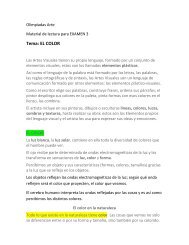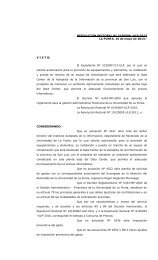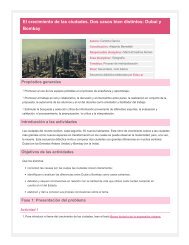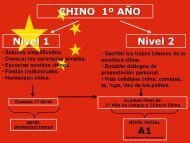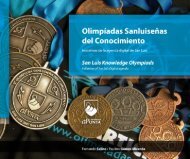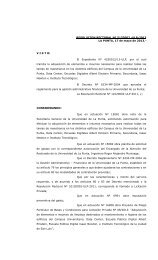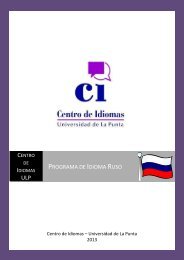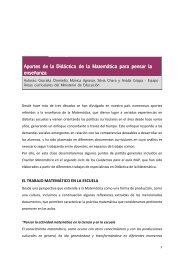e-Book PDF - Universidad de La Punta (ULP)
e-Book PDF - Universidad de La Punta (ULP)
e-Book PDF - Universidad de La Punta (ULP)
Create successful ePaper yourself
Turn your PDF publications into a flip-book with our unique Google optimized e-Paper software.
más <strong>de</strong> contemplar la meta <strong>de</strong> ofrecer el acceso a unacomputadora en estos centros para cada alumno queasista, el programa contiene los Núcleos <strong>de</strong> AprendizajePrioritarios (NAP) establecidos por el Ministerio <strong>de</strong>Educación provincial, para el nivel primario. Hasta mitad<strong>de</strong> 2010 se habían matriculado algo más <strong>de</strong> 1.000personas en estos centros.Los CID se instalan a partir <strong>de</strong> acuerdos celebradosentre la <strong>ULP</strong> y las distintas inten<strong>de</strong>ncias. Esto implicaun compromiso <strong>de</strong> parte <strong>de</strong> los municipios para lograrque se eleve el nivel <strong>de</strong> escolarización <strong>de</strong> sus comunida<strong>de</strong>s.Y con ello, un mejor futuro laboral-económicoa largo plazo. El docente a cargo <strong>de</strong>l CID es <strong>de</strong>signadopor la <strong>ULP</strong> mientras que el personal a cargo <strong>de</strong>l mantenimiento<strong>de</strong> las instalaciones corre por cuenta <strong>de</strong>lmunicipio involucrado.A los CID asisten adolescentes que no terminaron lasecundaria o que les fue tan mal en ese nivel que perdieronla escolaridad por un tema <strong>de</strong> edad. Y hacia arribano hay límites. Es posible encontrar a ancianos quesuperen los 70 o incluso los 80 años.Tres RotondasLlegamos a media mañana <strong>de</strong> un día hábil al CID <strong>de</strong>la zona conocida popularmente como “las tres rotondas”.Allí se ubica el barrio “131 Viviendas”, en las afueras<strong>de</strong> la ciudad <strong>de</strong> San Luis. Es un espacio amplio,alto, <strong>de</strong> un blanco impecable, por <strong>de</strong>ntro y por fuera,sostenido por columnas pintadas <strong>de</strong> un rojo intenso.Hace frío y un paro <strong>de</strong> transporte público afecta lanormal circulación <strong>de</strong> las personas pero igual llegaronalumnos a este lugar, caminando, en moto o enbicicleta.Alan Roldán (17) comenzó a ir al CID en abril <strong>de</strong> 2010.“Vine porque quise estudiar otra vez. Dejé la escuelahace cinco años para trabajar, cuando estaba en 5ºgrado, en un taller mecánico <strong>de</strong> motos en San Luis,don<strong>de</strong> sigo estando”. Con una sonrisa fresca que nose le borra en ningún momento, Alan quiere terminarla secundaria “y <strong>de</strong>spués ver lo que sale”. “Si no estudiono puedo hacer nada”, agrega.A diferencia <strong>de</strong> lo que suce<strong>de</strong> en las escuelas tradicionales,las clases en los CID son tres veces por semana,44 |to computers to stu<strong>de</strong>nts attending classes, the program also containsthe Priority Learning Cores (NAP for its name in Spanish Nucles<strong>de</strong> Aprendizaje Prioritario) set by the provincial Ministry of Educationfor the primary level. Around 1000 people had enrolled in these centersby mid 2010.The Centers are installed thanks to agreements signed by the Universityand the different city halls. This implies a commitment from the cityhall to raise the level of schooling in their communities. This leads toa better economic -work future in the long term. The teacher is appointedby the University while people in charge of the maintenance offacilities are charge of the city hall.The Centers receive many teenagers who did not finish their secondaryschool or who did so badly at the time that en<strong>de</strong>d up droppingout due to age issues. There is no age limit, it is likely to find 70 and 80years-old people attending classes.Tres Rotondas (Three Traffic Circles)We get to the Center in mid-morning of a working day in an areaknown as “tres rotondas” (three traffic circles). Nearby we find the “131homes” neighborhood, in the city’s outskirts. This is a big room, tall,painted in perfect white insi<strong>de</strong> and outsi<strong>de</strong>, and held by red paintedcolumns. It is cold outsi<strong>de</strong> and a public transportation strike affectsthe normal circulation of people, but stu<strong>de</strong>nts arrive to the place walking,riding bikes or motorbikes.Alan Roldan (17) began to attend classes at the Center in April 2010.“I came because I wanted to study again. I dropped out of school 5years ago when I was in 5th gra<strong>de</strong> to work in a motorbike workshopwhere I still work”. With a fresh permanent smile, Alan wants to finishhigh school “and then see what’s there to do”. “If I don’t study I can’t doanything”, he adds.Unlike traditional schools, classes at the Digital Inclusion Center takeplace three times a week in a preset time. The teacher gives stu<strong>de</strong>nts



